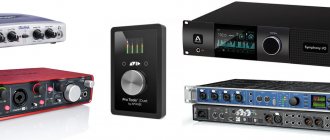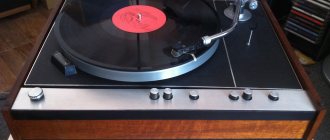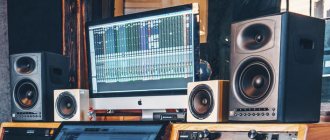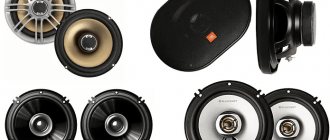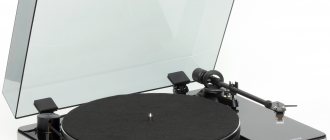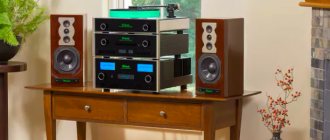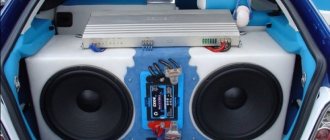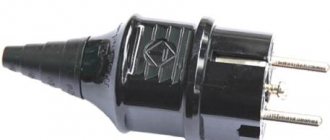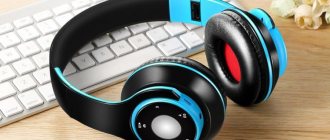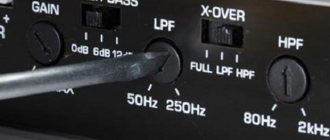How to choose a stationary DAC for your home audio system: 10 basic questions
Today I propose to dwell in detail on the choice of a stationary DAC for a home audio system. The device seems to be simple, but when purchasing a whole lot of unexpected questions and very important nuances arise. Today we will try to deal with them with you.
Pure DAC or with a headphone amplifier?
To begin with, I always suggest deciding what exactly we need: a pure DAC or a DAC combined with a headphone amplifier. Those who think that a DAC without an amplifier is cheaper are mistaken, their price is approximately the same. As an SMSL engineer once told me, adding a headphone output to a good DAC costs between 3 and 15 dollars. This is where the main problem lies; very often a headphone output is added to the DAC purely for the sake of it. That is, he is nothing special. Among such devices, I can cite the Loxjie D30, which I personally owned. A good device, but the headphone output is made according to the residual principle. Therefore, immediately take care of the question: what power is offered to us at the headphone output and what is the output impedance there? Good values for the first point are above 150 mW into a 32 ohm load, and for the second - about zero. Naturally, how this solution is implemented also matters, but the first two points already signal that this issue has been addressed. Among the decent and inexpensive options, I can cite, for example, Aiyima DAC-A5 Pro. It’s a really good well-thought-out path in terms of headphones, and it will rock any full-size headphones in no time. The absence of a headphone output means absolutely nothing. It’s just not there, which means the scope of use of the device is narrowing.
What outputs does a DAC need?
The next question concerns the outputs available to the DAC. Most inexpensive devices offer us classic RCA and this is normal, but it is very good when the DAC also has balanced connectors, for example XLR. An excellent example of such a device would be the same Topping DX7 Pro or SMSL M500. However, in very cheap models it is absolutely pointless to look for balanced outputs.
What inputs does the DAC need?
Well, don’t forget about the inputs we need. I personally prefer to connect the DAC directly to the computer, so the main one for me is the USB port. However, many people connect the DAC to a TV or some other device, where the digital signal can only be received via optical or coaxial cable. Here people are often lost, what to choose from this? The answer is as simple as possible: if you use cheap cables, then choose coaxial. For optical data transmission you need a fairly high-quality cable. If your cables are equally steep, then there is not much difference, since both of these inputs are always served by the same microcircuit. It would be nice to also have an AES input, but that’s just for aesthetes.
The presence of analog inputs or digital outputs is always optional. The first one essentially does not use a DAC, since the signal is initially analog, and the second one does not use it either, since the output is digital. What are they needed for? - the first one can, for example, simply work as an amplifier, and the second one can further transmit the signal to the next element of the circuit.
Switching or linear power supply of the DAC?
Now that we've sorted out the basics, it's time to talk about the main thing: nutrition. Most inexpensive DACs are equipped with pulse units. According to my measurements, there is nothing inherently wrong with this, if, of course, the wiring in your house is normal. Although, if possible, replacing the diet with a cleaner one will be extremely beneficial. When dividing a built-in unit or an external one, usually the built-in one is of higher quality, since it is able to provide separate power for different components. But, again, this is not the case at all with cheap DACs. Well, the risks are clear, the external unit can be easily replaced with a similar one, while the built-in unit must be taken to a service center and repaired. Which will undoubtedly come out more expensive.
Additional DAC Controls
We won’t talk about the presence of a remote control, a screen and switching filters - this is a matter of taste and color. I myself almost never use the remote control, and I perform the settings once when I turn on the DAC for the first time. It’s good, of course, if the DAC has switching amplification modes or a separate volume memory for the line output and headphones, but this is more of a “trinket”, in my opinion. Although if you really need this, then take a closer look at the Sabaj A10D on the AK4497EQ.
What USB chip is installed in the DAC?
But what really matters is what USB chip is used. I prefer devices exclusively on XMOS, since this is guaranteed to give us ASIO with updates, adjustable delay in samples, as well as stable operation on all modern systems. Old 32-bit applications for ASIO are not so good and can lead to problems when using some professional software. For example, if you decide to start writing music on your DAC in a Sonar, Cubase or some other sequencer.
This also leads to the limitations that we get if the DAC does not support ASIO at all. Then high-quality sound in Windows can be obtained exclusively through WASAPI Push and Event. Shared is completely unsuitable for us, since it uses the system mixer, with all its additional conversions and recalculation. As a rule, all good modern DACs are XMOS, with very rare exceptions. In the cheapest ones they prefer to install much simpler chips.
An additional mega plus of XMOS is the ability to connect to mobile devices with high quality signal transmission. If this is very important to you, please note it separately when purchasing. As an illustration of an inexpensive and very suitable DAC on XMOS, I can cite the FX-Audio D01. I've had the device for about half a year now and, in my opinion, it's extremely worthy.
What is the maximum audio resolution of the DAC?
Pay special attention to the resolution that the DAC can offer you. If it is 24 bits 96 kHz, then this device is as old as mammoth excrement. I personally would not recommend taking these. Good average values for today are 32 bits 384 kHz, and it is also desirable to support DSD256 and, if possible, MQA stream. By the way, it happens that the chip installed in the DAC can do a lot, for example, DSD and 32 bits 768 kHz, but in fact we only have 24 bits 192 kHz. Here questions begin to arise: how can this be? It's simple, the limiter in this case is an older USB or a receiver chip that can't do that. Well, the total capabilities of the device are calculated by its weakest element. To illustrate this difference between USB and coaxial, we can cite the FX-Audio DAC-X3 Pro DAC.
!.. About problems when using...
Here I would like to immediately warn you about problems that often occur among music lovers. The main one is crackling, wheezing and other sound artifacts. With what it can be connected? And the answer is quite simple: most DACs in their drivers have such an item as a delay with samples or milliseconds. This is usually an adjustable setting, highly dependent on your hardware. If your processor is a real hero, then the delay can be reduced a little, if not, you definitely need to increase it. I usually leave the value at 256 samples, and if necessary, such as heavy background CPU load, I increase it to 512 samples. For music, this parameter does not play a special role, so I recommend not making it too small, and you will be happy. Setting up the system mixer in Windows can also be a bottleneck. In this case, it is enough to raise its parameters, say, to 24 bits 96 kHz. This also happens.
Does the DAC need bluetooth?
But what about Bluetooth? - you ask me. Nothing special! In the DAC, bluetooth is used exclusively for reception. So that your guests can play their favorite music directly from their smartphone. Here it makes sense to check the version (preferably 5.x) and the presence of AAC, AptX, AptX HD and LDAC codecs. And so, transmission via Bluetooth is always associated with signal losses and not the highest quality conversion. It will work as a trick for a special occasion, but for the main connection it is better to use the good old wired connection. An example of a DAC with rich Bluetooth capabilities is the Topping D50s. It has long earned respect not only from amateurs, but also from professionals.
Tube or transistor, which is better?
Maybe use a DAC with tube amplification or transistors? Unfortunately, there is no clear answer here. If you like a warm, slightly dirty, but timbre-enriched sound, then the lamp will be very useful. Transistors also do not always give a perfectly clean, smooth result, everything may depend on the circuit design and wiring, but I would aim taking into account the rest of the path. Think about the sound quality of your external amplifier and what kind of acoustics? And most importantly, what would you like to change about all this? For example, a perfectly smooth amplifier and monitor speakers directly ask for a fat-sounding DAC in order to form a juicy, timbre-rich combination with it. Or, on the contrary, an old amplifier with a massive sound and post-Soviet acoustics require almost monitor sound with high detail to add sharpness, drive, detail and air to the sound. For a lamp I can cite, for example, Aiyima T8. A very good and inexpensive DAC.
What kind of USB-powered DACs are they? Can I take them?
Well, at the end of the day they always raise the question: what about DACs that get their power entirely via USB and do not require an additional connection? There are actually a lot of such DACs and audio interfaces and they really don’t need anything. There is only one downside and it is the low output power for the headphones. If this is not a problem for you, then there is nothing wrong with it. A good example of such a DAC would be the Loxjie D10 or the SMSL M100 MKII, if needed without a headphone amplifier. Excellent devices - I personally drove both of them.
Afterword
I am sure that the 10 questions and comments to them will help you not only choose the device that suits you, but also figure out what you actually need and whether there is an opportunity to save money. The only thing is that this time we did not touch on the topic of DACs with an already built-in amplifier for passive acoustics and the presence of replaceable op-amps. The latter, in my opinion, are a nice addition if you want to slightly adjust the sound to your own taste preferences. But the chips themselves need to be purchased not on Aliexpress. No matter how much he took from Ali, it didn’t matter whether it was expensive or cheap - they were always low-quality fakes. Here it is better to turn your attention to eBay or Amazon.
Well, that’s all for me; you can see the expanded list of stationary DACs from my recent selection or an earlier one. All the best and pleasant sound!
NAD M51 - DAC BUYER'S GUIDE
Lots of connections, high-quality sound for files of any type, clear display; NAD is back in the High End ranks
NAD components have not always been able to stand out from the crowd of competitors; the company is better known as a manufacturer of budget models, so releasing a DAC at this price is a bold move.
Motorcycle Emptiness Manic Street Preach is instantly addictive; the sound is characterized by a rare precision of drums
NAD emphasizes the unrivaled technical excellence of the M51 processor. According to her, the DAC converts the signal from PCM (Pulse Code Modulation) directly into a PWM (Pulse Width Modulation) form suitable for pulsed power amplification (Class D). This approach also significantly reduces jitter (timing errors), providing a high level of audio quality.
A bright path to music
Having heard the DAC in action, it's hard to disagree with this. The music delights with incredible purity and transparency; In Da Club 50 Cent sounds powerful and strong, with a solid bassline serving as a solid base for the melody. Motorcycle Emptiness Manic Street Preachers instantly grabs the listener; The sound is characterized by rare precision of drums and a clear, natural tone of guitar melodies. NAD recreates detail and sound textures that less expensive models cannot achieve. This can be heard both when playing a CD with 16-bit/44 kHz parameters, and when switching to HD files with 24/192 sampling. The latter are accepted through all inputs, including USB, coaxial, optical and AES/EBU.
The large black and blue vacuum fluorescent display is easy to read from afar; It displays the sample rate of the input signal as well as the volume level when using the M51 as a preamp. This useful feature will likely help you make the right choice (your digital system won't need a separate preamplifier), and it also improves sound quality by reducing signal paths. Connect the NAD to a power amplifier or a pair of high-quality powered speakers and you're good to go.
The construction quality is not bad for this category, but the front panel looks more solid than the other, thinner ones. A little more damping wouldn't hurt.
The M51 sounds absolutely magical; we'd go so far as to say it's one of the best NAD components we've seen.
HDMI spy
Having two HDMI inputs and one HDMI output is very unusual; This is the only test model equipped with HDMI connectors at all. They can be used in a variety of ways within a 2.0 system. The M51 can even extract a two-channel PCM signal from the stream coming from a Blu-ray player, and also transmit the image (including in 3D format) to the display. It is also possible to receive a high bitrate stream from DVD-A.
IN NUMBER LANGUAGE
USB ports
1 •
Digital.
coax inputs 1 •
Digital
optical Inputs 1 •
HDMI Inputs
2 •
RCA Inputs
0 •
XLR Inputs
1 •
RCA Outputs
1 •
XLR Outputs
0 •
Digital
optical outputs 0 •
Digital
coax outputs 0 •
HDMI outputs
1 •
Finishing options
1 •
Dimensions (HxWxD)
8x44x30 cm
NAD M51 $1570
RATING *****
FOR
Open, transparent sound;
incredible detail; realism; many connections; large, clear display CONS
Build quality doesn't match the price
VERDICT
Versatility and excellent sound for any high-end system
Based on materials from WHAT HI-FI? SOUND AND VIDEO
DACs are everywhere
An AV receiver, a CD, and, in principle, any media player are equipped with a unit with a digital-to-analog converter (DAC, converter, DAC). As an independent device, DACs appeared as a High-End upgrade to an existing CD player. The designers believed that it would be wiser to separate the player into separate units with their own power supply.
One of the first external DACs Sony DAS-R1, released at the end of 1987
In the first, the actual mechanical part with a readout optical system and a digital output was installed. It was called CD transport. In the second block there were no more moving nodes - only a DAC board, the importance of which has now grown to the title of a digital hub. By the way, it often happens that a modern CD player has a pair of digital inputs for connecting external sources.
The life cycle of sound from the source, subsequent recording and digitization, processing, and the reverse cycle - digital-to-analog conversion
A modern converter interacts with a number of signal sources - the main thing is that there is appropriate switching for everyone. The source can also be an old DVD player - they are usually connected via optical TosLink or coaxial cable. The latter looks like an ordinary “tulip” from a stereo pair. Expensive models may also use XLR connectors. Using the USB input, you can connect a computer or portable audio source to the DAC.
In addition, portable DACs are made compatible with sources based on iOS or Android phones, iPods, tablets and other gadgets. In fact, in all these cases, the converter becomes an external sound module with separate power supply and good hardware, which are unheard of in standard multimedia equipment. And modern DACs are often equipped with a headphone amplifier.

